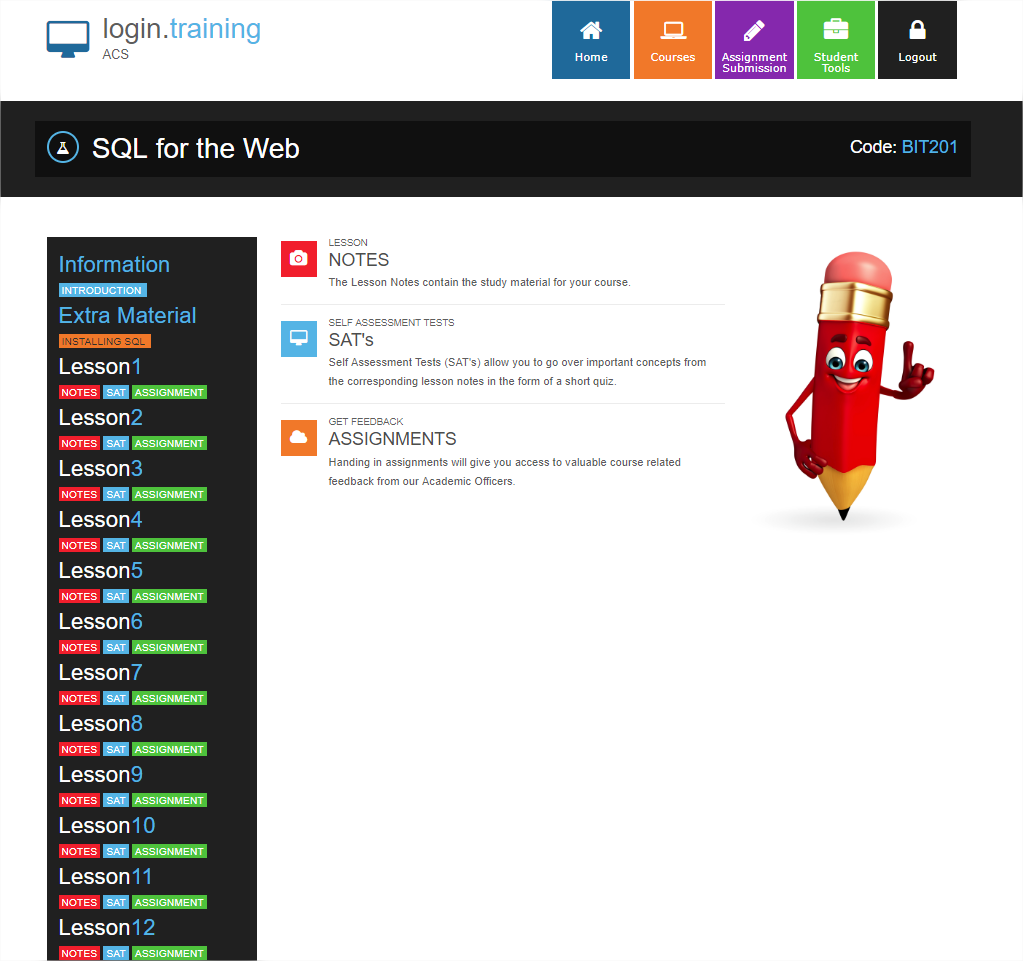
LEARN SQL AND DATABASE MANAGMENT
Gain valuable skills and knowledge in a growing and in-demand field of IT.
Databases in general are of the up most importance to businesses world wide and SQL is the most common and used language.
This course provides a comprehensive introduction to SQL. By the end of the course, the student should be able to easily understand all the major aspects of SQL.
Is this course right for me?
If you are a beginner, intermediate or professional in IT, this course is designed to provide a solid foundation on databases and the SQL language.
Study online at your own pace
Using our modern online portal for study is a simple and effective way of learning. Once enrolled, you will receive your online account to our login.training system that will give you all the lessons assignments and self-assessment tests so you can start studying straight away.

Course Structure and Content
There are 12 lessons in this course:
- Introduction to Databases
- Fundamentals of SQL
- Building a database with SQL
- Storing & Retrieving Data
- Advanced SQL database access methods
- Database Security
- Using SQL in applications
- Cursors
- Stored procedures
- Error Handling
- Dynamic SQL
- Advice & Tips
Each lesson culminates in an assignment which is submitted to the school, marked by the school's tutors and returned to you with any relevant suggestions, comments, and if necessary, extra reading.
The aims covered include:
- Understand the concept of relational databases.
- Understand the fundamentals of SQL.
- Build and maintain a database with SQL.
- Define how to store data in a database using SQL.
- Understand advanced and more efficient ways of working with databases in SQL.
- Keep databases secure with SQL.
- Understand how to use SQL in real world applications.
- Define how to use cursors to work with data in a database.
- Understand how to re-use common code and develop efficient database driven applications with the use of stored procedures.
- Define the benefits of error handling and how to implement it.
- Define how dynamic SQL works in applications.

What is SQL?
SQL (structured query language) is the most common language used for communicating with relational databases.
Traditionally, programming languages such as Basic, C# and C++ are known as ‘procedural’ languages. This means that in order to do something, a procedure is written telling the computer what to do.
For example, to get the computer to draw a box, you would have a procedure similar to the following:
- Move the pointer to the top left of the screen
- Draw a line horizontally until it reaches the edge of the screen
- Draw a line down until it reaches the bottom of the screen
- Draw a line to the left until it reaches the left hand side of the screen
- Draw a line up until it meets the top left corner of the screen
SQL is a ‘non-procedural’ language. Instead, you tell SQL what you want and it communicates with the DBMS to retrieve your request without you having to tell SQL exactly how to do it.
For example, to retrieve all records from a database where all people lived in Australia, you would use the following SQL command:
Select * from records where location=’Australia’
The DBMS then understands what SQL is asking and will go and retrieve the data and send it back to SQL.
SQL commands are performed in one of two ways:
1) Via a console
You can execute SQL commands via a console that is connected to a DBMS. This may be the SQL query builder in Microsoft Access, a web page connected to a database of some sort, or either via SQL Server Express, Enterprise Manager & Query Analyser for SQL Server. You would simply type in your request in SQL and after the task has been completed, you will see the result. This form of using SQL is generally only used by professional database administrators due to the large margin for error and lack of database security (someone could easily wipe out a database by typing the wrong command).
2) Via an application
This is the most common form of SQL programming. An application acts as a ‘front end’ for the database, allowing someone with basic computer knowledge to use a database. For example, a button that says ‘add record’ would appear on a page with blank fields for ‘name’ and ‘address’. The operator would enter the name and address then click the button. This button would then fire off an SQL command, telling the DBMS to add a new record to the database with the data the operator typed in.

WHAT IS COVERED IN EACH LESSON?
- Introduction to Databases
- What is a database
- DBMS
- The relational model
- Primary keys
- Foreign keys
- Relationships
- Normalisation
- Other normal forms
- De normalisation
- Fundamentals of SQL
- Installing a DBMS
- SQL
- The select statement
- Common errors
- Identifiers
- Building a database with SQL
- Building a database: RAD tool, CSV file, opening database, commands, etc
- Data types and MS access
- Retrieving, Storing, Updating and Deleting Data
- Retrieving data
- Retrieving from tables with relationships
- Creating column aliases
- Eliminating duplicate rows
- Filtering rows with WHERE
- Matching patterns with LIKE
- Escaped and unescaped patterns
- Range filtering with BETWEEN
- List filtering with IN
- Evaluating conditional values with CASE
- Sorting rows by ORDER BY
- Storing, updating and deleting data
- Updating rows with UPDATE
- Deleting rows with DELETE
- Advanced SQL database access methods
- Relational databases
- Creating outer joins with OUTER JOIN
- Subqueries
- Summarising data
- Grouping rows
- Using HAVING for filtering rows
- Set operations
- Union
- Intersect
- Except
- Handling duplicates
- Database Security
- Security is important
- Triggers
- Using SQL in applications
- Using SQL in an application
- Using SQL in web sites
- Using SQL in desk top applications
- Using SQL in mobile devices
- Embedded SQL
- SQL injection
- Cursors
- What are cursors
- Preventing updates and deletions
- Scrollable Cursors
- Stored procedures
- Introduction
- Compound statements
- Stored functions
- Stored modules
- Views
- Indexes
- Controlled flow statements
- Error Handling
- Dynamic SQL
- Introduction
- Execution of dynamic SQL
- Single step execution
- Two step execution
- Dynamic cursors
- Advice and Tips
- Common mistakes
- Assuming the client knows what they need
- Underestimating project scope
- Only considering technical factors
- Not seeking client feedback
- Skipping beta testing
VALUABLE KNOWLEDGE LIKE THIS IS PRICELESS
When you talk IT, one of the most common things that a business will have is a database of some sort. SQL is the worlds leading database language and learning this will give you the skills to branch out into many different areas.
Not all databases are built the same, however when you have a foundation like this, there is very little that you will not be able to accomplish.
In fact the database job growth estimated between 2014 and 2024 is set to grow 11percent, which makes it the fastest growing career in the world!!
Having these skills equips you for the future and the growing demand in IT, currently the fastest moving industry in the world.
You can take these skills anywhere in the world and find work as SQL is used by every major country across many different industries.
Some of the titles you will find in the IT industry related to databases are:
- Database Administrator
- Database Developer
- Database support and maintenance
- Database security
- Data miner
- Data reporting and business integration
Other areas of IT that relate/integrate to databases you can study in future to expand your skills even further include:
- Computer programming
- Computer security
- Web development
- Networking Business
- Analysis Marketing
To find out more or speak to one of the Tutors please use the live chat at the bottom of this page.
To Enrol and take the next step in your career, Click the "Enrol" button at the top of this page.